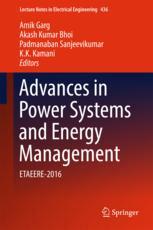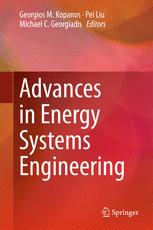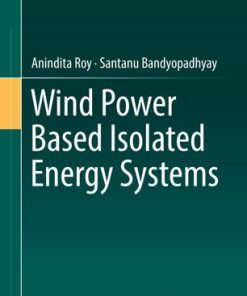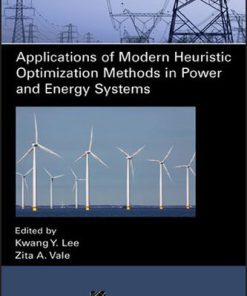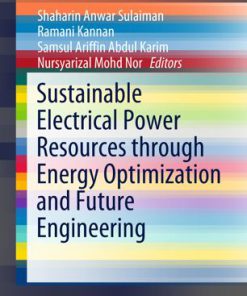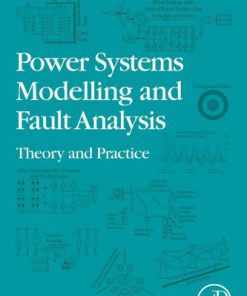Power and Energy Systems Engineering Economics 1st Edition by Panos Konstantin, Margarete Konstantin ISBN 3319723820 97
$50.00 Original price was: $50.00.$25.00Current price is: $25.00.
Power and Energy Systems Engineering Economics 1st Edition by Panos Konstantin, Margarete Konstantin – Ebook PDF Instant Download/Delivery: 3319723820, 978-3319723822
Full dowload Power and Energy Systems Engineering Economics 1st Edition after payment
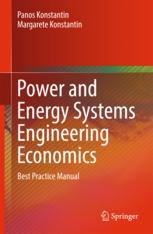
Product details:
ISBN 10: 3319723820
ISBN 13: 978-3319723822
Author: Panos Konstantin, Margarete Konstantin
Power and Energy industry is a highly capital intensive business field. Furthermore there is a very close interlinkage between technologies and economics that requires engineers and economists to have a common understanding of project evaluation approaches and methodologies. The book’s overall objective is to provide a comprehensive but concise coverage of engineering economics required for techno-economic evaluation of investments in power and energy system projects. Throughout the book, the emphasis is on transferring practical know-how rather than pure theoretical knowledge. This is also demonstrated in numerous examples derived from experience of respective projects.
The book comprises seven chapters. The text part is supported by about 25 tables, 40 figures, 55 application examples and 7 Case Studies.
Target audience of the book are primarily international consultants, staff members of engineering companies, utility personnel, energy economists and lawyers, as well as employees of government agencies entrusted with regulating the energy and utility sector and, finally, students in related fields of engineering and economics.
Power and Energy Systems Engineering Economics 1st Table of contents:
1. Introduction and Scope
1.1 Brief Outline of the Chapters
1.2 Annexes
1.3 Glossary
2. Financial Mathematics
2.1 Synopsis of the Chapter
2.2 The Time Value of Money
- 2.2.1 Some Key Definitions of Terms
- 2.2.2 The Time Value of Money
2.3 Single Payments - 2.3.1 Compounding a Single Payment
- 2.3.2 Discounting of a Single Payment
2.4 Series of Unequal Payments - 2.4.1 Compound Amount of a Series of Unequal Payments
- 2.4.2 Present Value of a Series of Unequal Payments
2.5 Series of Equal Payments - 2.5.1 The Mathematical Structure of Series of Equal Payments
- 2.5.2 Compound Amount of a Series of Equal Payments
- 2.5.3 Present Value of Series of Equal Payments
- 2.5.4 Annual Equivalent Amounts of Payments (Annuities)
2.6 Series of Escalating Payments - 2.6.1 The Present Value of a Series with Escalating Payments
- 2.6.2 Levelized Values of Escalating Series of Payments
3. Inflation, Interest and Cost of Capital
3.1 Synopsis of the Chapter
3.2 Inflation & Price Index
3.3 Policy Instruments for Controlling Inflation
3.4 Interest Rates and Inflation
3.5 Exchange Rate Fluctuations of Currencies
3.6 Interest Rate Formulas
- 3.6.1 The Nominal Interest Rate
- 3.6.2 The Real Interest Rate
- 3.6.3 The Effective Interest Rate
3.7 Discount Rates – Weighted Average Cost of Capital
4. Investment Appraisal Methods
4.1 Synopsis of the Chapter
4.2 Overview of Investment Appraisal Methods
- 4.2.1 Overview of Appraisal Methods
- 4.2.2 Definition of the Components of the Appraisal Process
4.3 The Net Present Value Method – NPV - 4.3.1 Net Present Value of an Investment
- 4.3.2 Net Present Costs (NPC) and Levelized Cost (LEC)
- 4.3.3 Calculating LECs of Escalating Cost Series
- 4.3.4 Dynamic Cost-Based Tariff
4.4 The Internal Rate of Return Method – IRR - 4.4.1 Internal Rate of Return on Investment (IRROI)
- 4.4.2 Internal Rate of Return on Equity (IRROE)
4.5 Annual Equivalent Amounts or Annuity Method - 4.5.1 The Annual Equivalent Amount of an Investment
- 4.5.2 Calculation of Levelized Cost with the Annuity Method
- 4.5.3 Application of the Method for Series with Escalation
4.6 Payback Time Method
4.7 Return on Investment (ROI)
5. Financial and Economic Analysis of Projects
5.1 Synopsis of the Chapter
5.2 Financial Analysis vs. Investment Appraisal
5.3 Financial Analysis
- 5.3.1 The Discounted Cashflow Model
- 5.3.2 Approach for Sales Revenues and Depreciation
- 5.3.3 Financial Performance Ratios
5.4 Economic vs. Financial Analysis - 5.4.1 Introduction
- 5.4.2 Transfer Payments
- 5.4.3 Sources of Financing and Discount Rate
- 5.4.4 Pricing of Goods and Services
- 5.4.5 Externalities
- 5.4.6 Required Skills for Conducting Economic Analysis
5.5 Benefit-Cost Analysis of Public Projects
6. Introduction to Cost Allocation for Cogeneration Products
6.1 Synopsis of the Chapter
6.2 The Principle of the Cogeneration Cycle
6.3 Cost Allocation Methods
- 6.3.1 The Residual Value Method
- 6.3.2 The Electrical Equivalent Method
7. Project Analysis under Uncertainties
7.1 Synopsis of the Chapter
7.2 Sensitivity Analysis
7.3 Break-even Point Analysis
- 7.4.1 Project Analysis Based on Scenarios
- 7.4.2 SWOT Analysis
7.5 Uncertainty Analysis of Energy Production - 7.5.1 The Normal Distribution
- 7.5.2 Exceedance Probability
7.6 Risk Analysis and Risk Mitigation - 7.6.1 Certainty and Uncertainty Aspects of Electricity Business
- 7.6.2 Types of Risks and Mitigation Measures
7.7 Consideration of Risk Premiums in Discount Rate - 7.7.1 Risk Premiums
- 7.7.2 Risk Exposure of Equity Investors and Lenders
- 7.7.3 Estimating Risk Premiums for Different Project Types
- 7.7.4 Country Risks
- 7.7.5 Hedging Country Risks with Export Credit Guarantees
- 7.7.6 Officially Supported Export Credits, OECD Arrangement
- 7.7.7 Credit Ratings
8. Overview of Energy Markets and Prices
8.1 Synopsis of the Chapter
8.2 Definitions of Energy Terms
- 8.2.1 Forms of Energy
- 8.2.2 Heating Value of Fuels
8.3 The Wholesale Market of Fuels - 8.3.1 Crude Oil
- 8.3.2 Steam Coal
- 8.3.3 Natural Gas
- 8.3.4 Heating or Calorific Price and Price Relations of Fuels
- 8.3.5 End-User Fuel Prices – Domestic Fuel Transport Cost
- 8.3.6 Nuclear Fuel
8.4 Conclusions and Recommendations for Fuel Price Forecasts - 8.4.1 Proposed Approach for Fuel Price Escalation
- 8.4.2 Fuel Prices Based on Opportunity Costs
9. Case Studies
9.1 Synopsis of the Chapter
9.2 Basic Techno-Economic Models
- 9.2.1 Thermal Price of Fuels and Electricity Fuel Cost
- 9.2.2 Calculating Composite Electricity Price
- 9.2.3 Calculating CAPEX Including IDC and Reinvestments
- 9.2.4 Levelizing Feed-in Tariffs
9.3 Modeling Energy Balance for Power Generation
9.4 Integrated Models for Electricity Generation Costs
9.5 Lifetime Costs Model for Different Load Regimes
9.6 Internal Rate of Return and Cashflow Analysis - 9.6.1 Internal Rate of Return Model
- 9.6.2 Cashflow Analysis Model
People also search for Power and Energy Systems Engineering Economics 1st:
power and energy systems
systems engineering and economics
the energy system technology economics markets and policy
engineering-economic systems
You may also like…
Engineering - Energy & Power Resources
Engineering - Energy & Power Resources
Engineering - Electrical & Electronic Engineering
Power Systems Modelling and Fault Analysis Theory and Practice 2nd Edition Nasser Tleis
Uncategorized




